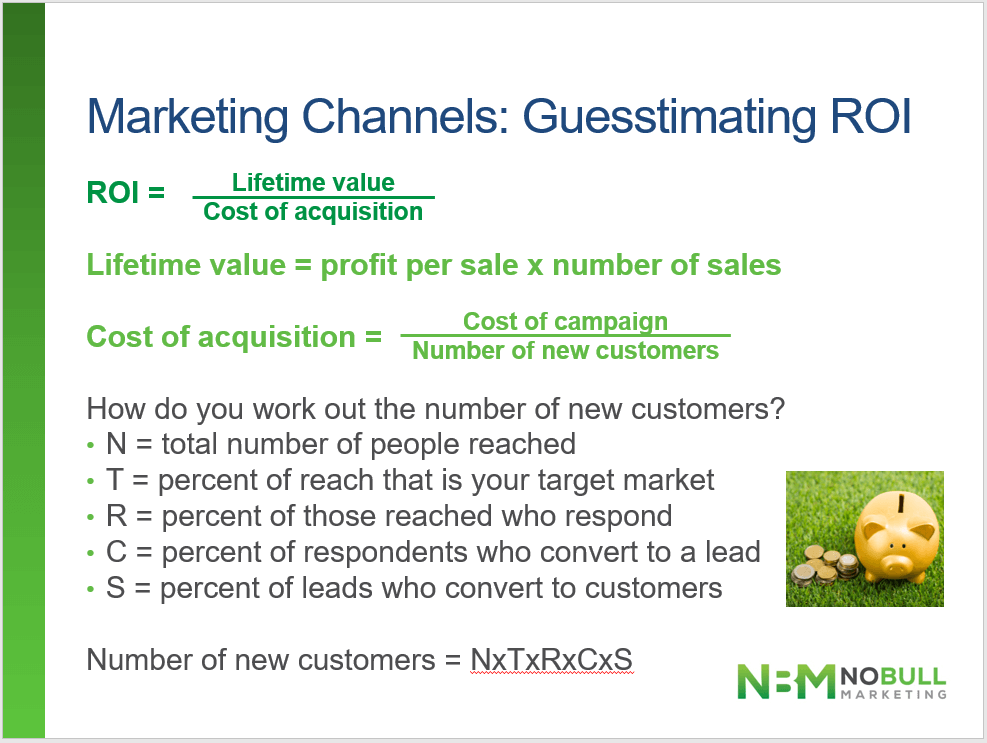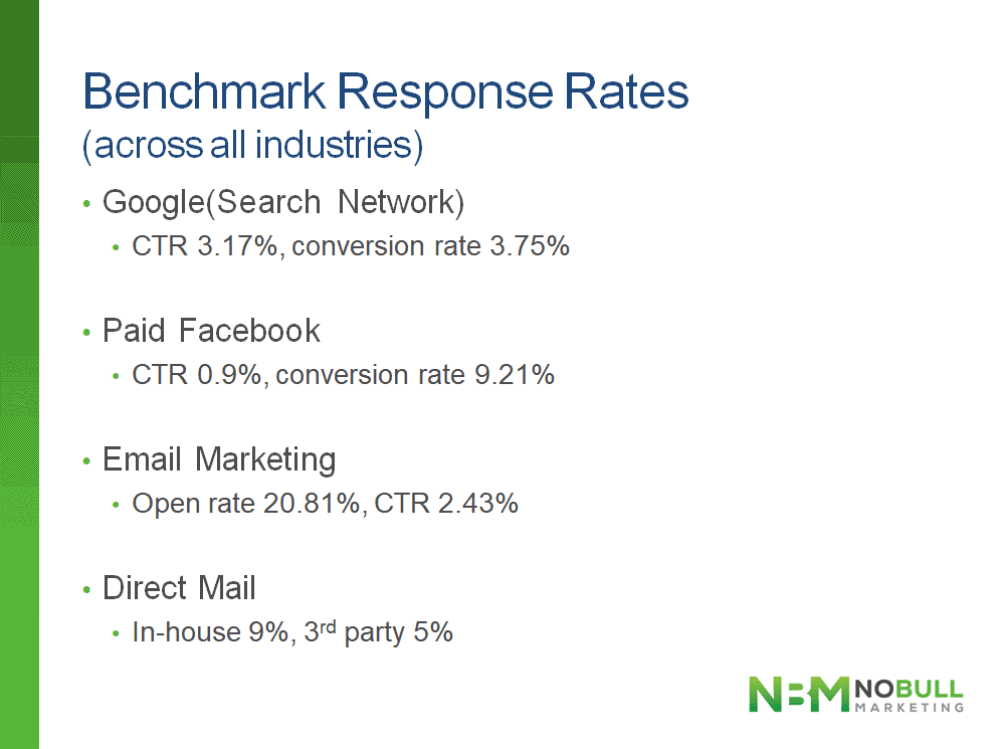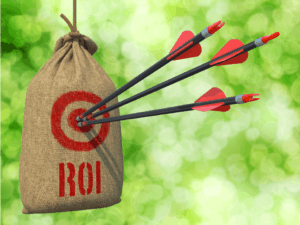Let’s imagine a company is quoting you a price to promote your services to their email list or to send direct mail to their contacts. How do you decide whether you should? Will you get a positive return on the investment you make using the third-party channel?
The short answer is, you’ll never know for sure. But you can make an educated guess. A guesstimate.
Here’s how you do it.

That slide might look complicated, but let’s break it down bit by bit.
Lifetime Value
This is one of the two key metrics you should be tracking for your own business. How much is a customer worth to you?
There are many ways you can calculate this, depending on your business. But if you don’t have any idea, the simplest way is to look at a year’s business. Divide your profit by the number of customers you had in the year. That’s a good number to start with.
Cost of Acquisition
You know what price you were quoted for this campaign. You just don’t know how many customers you could get from it. Here’s where we need to start guesstimating!
Total number of people reached
Get this from the person selling to you.
How many addresses on the email list? How many contacts on the database? It’s as simple as that.
Percent of people on the list who are your target market
This is important but so often people forget about it.
Imagine someone (an auto parts supplier) offers you a chance to email a whole load of motor mechanics. If you’re selling toolboxes or workboots, that’s a good fit. Pretty much every motor mechanic could be interested. But what if you run a beauty spa?
With an example like that, it’s pretty obvious, but if there’s some overlap, things get trickier.
For example, B&T is a site all about marketing. Their email subscribers are all interested in marketing. But they are not all marketing managers. Many are marketing agencies. Others are printers, software suppliers and consultants, who want to know what marketers are thinking about and talking about.
The easiest way to find out how many marketing managers are on the list is to ask. Companies that offer a promotional email deal usually know some basic things about their subscribers. Some you might want to consider are:
- Job title / role
- Industry
- Company size
- Location (especially if you only work in one state)
For consumer businesses, it might be:
- Gender
- Age
- Income
- Marital status
- Whether they have children
- Location
And so on.
Remember, the size of the list doesn’t matter. What matters is how many people on the list are in your target market!
What’s the expected response rate?
Your supplier may be able to give you an average response rate.
If not, this slide shows some averages across all industry sectors for different kinds of the campaign. Wordstream and MailChimp update the numbers fairly regularly, and there are also breakdowns by industry, so check the links below the slide for the most accurate data.

You can check out updated and industry-specific response rates via the following links.
- Google(Search Network): https://www.wordstream.com/blog/ws/2016/02/29/google-adwords-industry-benchmarks
- Paid Facebook: https://www.wordstream.com/blog/ws/2017/02/28/facebook-advertising-benchmarks
- Email Marketing: https://mailchimp.com/resources/email-marketing-benchmarks/
- Direct Mail:
https://www.iwco.com/blog/2019/01/16/direct-mail-response-rates-dominate-other-channels/
For email marketing, there’s one more important thing to consider. Is the entire email dedicated to your offer? Or is it one of many possible links people could click on?
The second scenario is usually cheaper, but be aware you’ll get fewer clicks. You are even less likely than with other email to have the reader’s full attention!
Are the respondents leads or customers?
In other words, are they enquiring, or are they actually buying?
If they’re buying, your conversion rate is 100%. Every single person who responds becomes a customer.
If they’re enquiring, you still have to convert them to customers. On average, how many opportunities do you need to gain one customer? That’s the figure you need for this project of guesstimating ROI.
The best way to do this is with a worked example.
First example
Let’s assume I’m selling marketing software of some kind, to marketing managers. My lifetime value is $7,000.
Let’s look at the B&T list. There are 30,000 subscribers and it will cost $6000 to email them in a solus EDM. (‘solus EDM’ is marketing speak for a dedicated email about my software.)
When I speak to B&T, they tell me that the clickthrough rate is usually about 2.5%. They also tell me the list is about 40% of marketing managers, with another 5% whose job role is unknown.
Here’s how the calculation goes:
- N is the total number of emails on the list. N=30,000
- T – target market – is 40% of the total list. T=40%
- R is the response rate, in this case, the clickthrough rate. R=2.5%
- C – the conversion rate, measures how many of the people who click actually fill in my form and give me some information. In a recent test, this was 25%, so I’m going to use that. C=25%.
- S is the number of leads who actually convert to sales. Let’s put that at 1 sale for every 10 leads, or 10%
So overall I can guesstimate that I will get
30,000 x 40% x 2.5% x 25% x 10% = 7.5 new customers.
Obviously we won’t get half a customer. We’re being cautious. Let’s round it down. 7 customers.
At $7,000 lifetime profit per customer, I can expect to make $49,000 profit.
The campaign will cost me $6,000. That’s an ROI of $49,000/6,000, or 817%.
Should I do it? Hell yeah!

Second example
Let’s keep the same scenario, but I’m a different company. This company offers marketing event management services. The average lifetime value is still $7,000, but the company only operates in Brisbane.
So now my target audience is marketing managers in Brisbane. That’s a much smaller market.
B& T can’t tell me where their subscribers are. They only have email addresses. But I do some quick web research. There are around 2.5 million people in Brisbane and 25 million in Australia overall. About 10% of the population is in Brisbane.
I assume marketing managers are spread around the country the same way everyone else is. So now only 10% of 40% of the list are in my target market. That’s 4%. And the equation changes to:
30,000 x 4% x 2.5% x 25% x 10% = 0.75 new customers.
Should I do it? Probably not.
Unless I think there’s other value.
Maybe some marketing managers in NSW and VIC also run events in Brisbane and don’t have someone to manage them. Maybe I can extend to service customers on the Gold Coast. Maybe the brand awareness is worth something. But those are all maybes.
Or I could go back to B&T, explain the problem and ask for a discounted rate. They might just agree!
***
Whatever I decide to do, this little bit of maths has helped me know where I stand and assess my options.
And of course, if you’re trying to decide which of two or more options is best, it’s even more useful!


